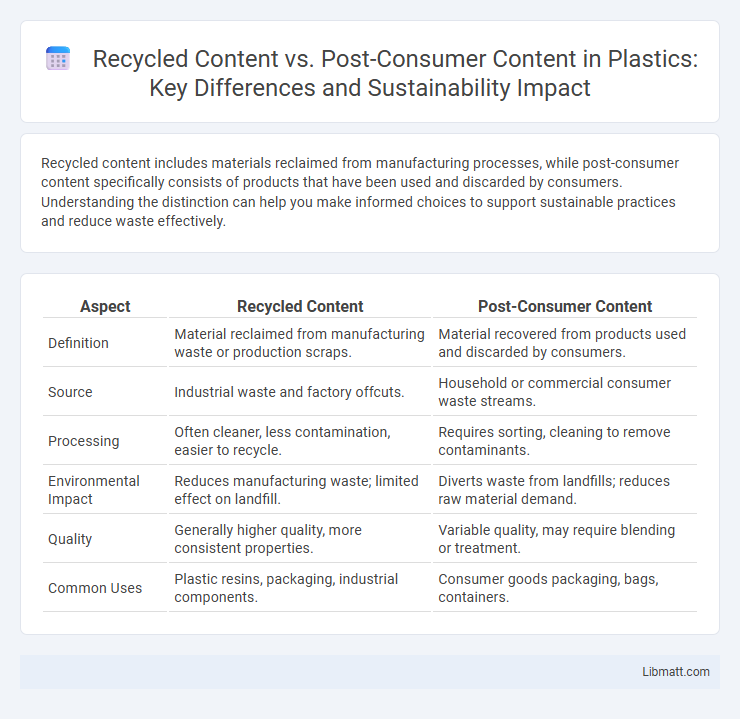Recycled content includes materials reclaimed from manufacturing processes, while post-consumer content specifically consists of products that have been used and discarded by consumers. Understanding the distinction can help you make informed choices to support sustainable practices and reduce waste effectively.
Table of Comparison
| Aspect | Recycled Content | Post-Consumer Content |
|---|---|---|
| Definition | Material reclaimed from manufacturing waste or production scraps. | Material recovered from products used and discarded by consumers. |
| Source | Industrial waste and factory offcuts. | Household or commercial consumer waste streams. |
| Processing | Often cleaner, less contamination, easier to recycle. | Requires sorting, cleaning to remove contaminants. |
| Environmental Impact | Reduces manufacturing waste; limited effect on landfill. | Diverts waste from landfills; reduces raw material demand. |
| Quality | Generally higher quality, more consistent properties. | Variable quality, may require blending or treatment. |
| Common Uses | Plastic resins, packaging, industrial components. | Consumer goods packaging, bags, containers. |
Understanding Recycled Content: Definition and Types
Recycled content refers to materials that have been recovered or diverted from the waste stream and reprocessed into new products. It includes two primary types: post-consumer content, which comes from materials used and discarded by consumers, and pre-consumer content, originating from manufacturing waste or scraps. Understanding these distinctions helps you make informed choices about sustainable products that reduce environmental impact.
What is Post-Consumer Content?
Post-consumer content refers to materials that have been used and discarded by consumers, then collected and processed for recycling into new products. It represents a sustainable approach by diverting waste from landfills and reducing the demand for virgin resources. Brands and industries prioritize post-consumer content to enhance environmental responsibility and promote circular economy practices.
Key Differences: Recycled Content vs Post-Consumer Content
Recycled content includes materials recovered from manufacturing scraps or pre-consumer waste, while post-consumer content specifically refers to materials collected after product use by consumers. The key difference lies in the source of the materials: recycled content may come from any stage of the product lifecycle, whereas post-consumer content comes exclusively from the end-users after product disposal. Understanding these distinctions is crucial for accurate sustainability reporting and certifications in eco-friendly product development.
The Environmental Impact of Each Material
Recycled content refers to materials reclaimed during the manufacturing process, reducing waste and conserving resources by reusing scraps and offcuts. Post-consumer content is sourced from products that have completed their lifecycle, helping to divert waste from landfills and lowering the demand for virgin materials. Your choice between recycled and post-consumer content can significantly influence the environmental footprint by promoting resource efficiency and reducing pollution.
Sourcing and Supply Chain Considerations
Recycled content is derived from manufacturing waste and scrap materials, while post-consumer content comes from products discarded by consumers after use, impacting sourcing channels and supply chain reliability. Your choice influences procurement complexity, as post-consumer content requires robust collection systems and quality sorting to maintain material consistency. Suppliers specializing in post-consumer materials often face fluctuations in input availability, necessitating flexible inventory management to ensure steady production.
Certifications and Industry Standards
Recycled content and post-consumer content certifications are governed by standards such as the Forest Stewardship Council (FSC) and the Sustainable Forestry Initiative (SFI), which verify the percentage and source of recycled materials. The Global Recycled Standard (GRS) specifically certifies products containing post-consumer recycled content, ensuring traceability and environmental compliance throughout the supply chain. Industry benchmarks like ISO 14021 further regulate environmental claims, distinguishing between pre-consumer and post-consumer recycled materials for transparency and consumer trust.
Applications in Packaging and Manufacturing
Recycled content in packaging and manufacturing typically includes materials recovered from manufacturing waste, while post-consumer content comes from products discarded by consumers. Your packaging choices impact sustainability goals, as post-consumer content often offers higher environmental benefits by diverting waste from landfills. Both materials are crucial for circular economy efforts, with applications ranging from cardboard boxes and plastics to metal components and textiles in various industries.
Consumer Perception and Marketing Claims
Recycled content includes materials reclaimed during manufacturing, while post-consumer content originates from products used and discarded by consumers, influencing consumer perception significantly. Your marketing claims emphasizing post-consumer content resonate more with eco-conscious buyers seeking genuine waste reduction and circular economy support. Transparent labeling and certification of recycled versus post-consumer content enhance brand trust and differentiate products in sustainability-focused markets.
Regulatory Requirements and Compliance
Regulatory requirements for recycled content often mandate minimum percentages of recycled materials sourced from either post-consumer or pre-consumer streams, with compliance verified through certification schemes like ISRI or EPA standards. Post-consumer content regulations emphasize materials reclaimed after consumer use, necessitating rigorous documentation to ensure transparency and traceability in supply chains. Companies must adhere to regional laws such as the EU's Waste Framework Directive or the U.S. FTC Green Guides, which define compliance criteria and promote environmental responsibility in product labeling.
Future Trends in Sustainable Material Use
Future trends in sustainable material use emphasize increasing the integration of recycled content, particularly post-consumer content, to reduce environmental impact and promote circular economy principles. Advancements in sorting technology and chemical recycling enable higher-quality material recovery, making post-consumer recycled content more viable for diverse applications. You can expect product innovations that prioritize transparency and certification to validate the percentage of recycled content, driving consumer trust and regulatory compliance.
Recycled Content vs Post-Consumer Content Infographic

 libmatt.com
libmatt.com